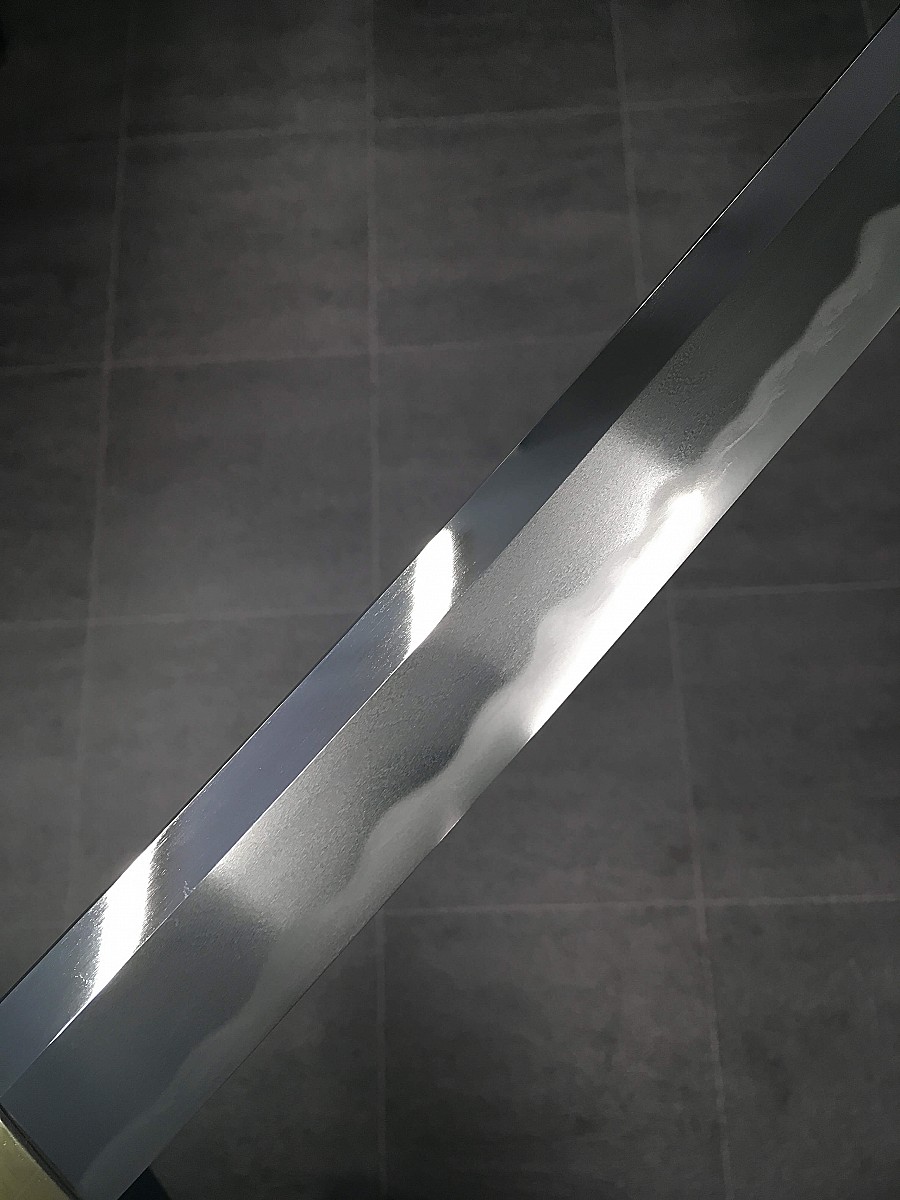Satsuyō Oku Motohira (薩陽奥元平) was born in the 10th month of the 1st year of the Enkyō era (延享, 1744). He was the eldest son of Oku Motonao (奥元直). Motohira was given the name Kyōzaemon (孝左衛門) at birth and it is said that he also born the first name Jirōbei (次郎兵衛). His father, Motonao, died on May 18, 1777 and two month after (on July 11, 1777) Motohira succeeded as the head of the Oku family. He was invited in the Satsuma Province in the 5th year of the Tenmei era (天明, 1785) and was granted after to sign his works with the supplement: Sappan-shi (薩藩臣, it can be literally translated as «retainer of the Satsuma fief»). In recognition of his excellence, Motohira was born and raised in Satsuma and his lineage long resident in Satsuma Province and he was appointed by the 8th Satsuma Lord, Lord Shimazu Shigehide and along with Sasshū Masayoshi (正良) were made official Han swordsmiths to the Shimazu family.
Motohira received the honorary title Yamato no Kami (大和守) in the 1st day of the 12th month of the Kansei era (寛政, 1789). Motohira forging style was generally expressed in the Sōshū tradition but was also quite experimental and productive, which is seen in his various interpretations, this speaks for his ambition and enthusiasm for the swordsmithing art. He died on the 13th day of the 7th month of the Bunsei 9 (文政, 1826) in the 83rd year of his life.
Motohira, in his early period of when he was signing Satsuyō-shi Oku Motohira (薩陽士奥元平) and Sappan-shin Oku Motohira (薩藩臣奥元平), and his brother Mototake worked closely in the style of Inoue Shinkai (井上真改), which of course Sōshū-Den as Inoue Shinkai was nicknamed the ‘Masamune of Ôsaka’. Motohira and Mototake excelled in copying this workmanship, and indeed that the former’s workmanship was so good that his works have been mistaken for Inoue Shinkai.
Satsuyō Motohira’s works have the following distinguishing features:
Sugata: large dimensioned with shallow sori, broad and not that tapering mihaba, a thick kasane and plentiful of hira-niku, the elegant blades from his later years are rather an exception, the shinogi-ji remains narrow, even when the mihaba is broad.
Kitae: dense and hardly discernible ko-itame mixed with ō-hada and Satsuma-gane, the ji-nie are rough and sometimes also yubashiri appear, the shinogi-ji is muji, i.e. it does not show any hada structures.
Hamon: is composed of quite rough nie and starts with a narrow yakidashi, the hamon becomes broader towards the tip and also the nie increase in that way, the roughest nie can be seen in the monouchi area where they spill into the ji and become ji-nie, in his early years he also applied calm hamon like suguha or notare-midare, after the Tenmei era (天明, 1781-1789) he changed in favour to the flamboyant and magnificent Satsuma-typical gunome-midare with thick nie and nioi, mixed with togari which consists of nie, plentiful of hataraki like sunagashi and imozuru.
Bōshi: ko-maru, midare-komi or ichimai, but always nie-loaden.
Horimono: different types of hi are most common.
Nakago: the tang is relative long and has a tanagobara shape, the tip is in kengyō-jiri form and the yasurime are sujikai, he signed often with a tachi-mei, some blades show on the nakago-jiri one or two horizontal chisel strokes, they are considered as secret marks of the first generation Motohira.
This katana is an excellent example of the first generation Motohira workmanship. Sword was designated as Tokubetsu Hozon Tōken and have a long sayagaki by Tanobe-sensei.
Signed: Oku Yamato no Kami Taira Ason Motohira (奥大和守平朝臣元平)
Dated: on the 10th year of the Kansei era (寛政, 1798).
Nidai Oku Motohira
The second generation of Motohira (元平) was born in the 4th year of the Tenpō era (天保, 1833) and his activity period indicates as Ansei era (安政, 1854-1860). He was given the name „Oku Jirōbei (奥次郎兵衛) at birth and was the grandson of the first generation Motohira. Motohira (second generation) succeeded as the Nidai Oku Motohira family in Tenpō 14 (天保, 1843) at the age of ten because his father Motohiro (元寛) died at a young age. Motohira studied under Motoyasu (元安), he was quite fat and so he got the nickname Buta-Motohira (豚元平, that can be literally translated as «pig Motohira»). He died at the 73rd year of his life in the 21st day of the 11th month of the Meiji 38 (明治, 1905). Signatures variants: Sasshū-jū Oku Motohira saku (薩州住奥元平作); Satsuyō Oku Motohira (薩陽奥元平); Satsuyō-shi Oku Taira Motohira (薩陽士奥平元平).
For more information about Nidai Oku Motohira please see Markus Sesko article on: https://markussesko.com/2016/12/09/nidai-oku-motohira/
Tantō signed: Satsuyō-shi Oku Motohira saku (薩陽士奥元平作).
Dated: on a lucky day in the 8 month of the 1st year of the Keiō era (慶應, 1865).
The license shows that it was issued in Kagoshima in 1954 so it had lived all its life in old Satsuma and probably came out of an old Kagoshima samurai family.
This tantō has a really very rare sugata — kanmuri-otoshi-zukuri (冠落し造) with a non-standard form of sugata. It is a rare form and it was accompanied with a bo-hi (naginata-type) usually. Unfortunately, quality of photo is not allow to see all particularities of the sword’s forging but video (located above the text) is much better.
This Motohira tantō came to exhibition from an American collector. Following the owner’s comments, tōrokushō shows that it was issued in Kagoshima in 1954 so this tantō had lived all its life in old Satsuma and probably came out of an old Kagoshima samurai family.






